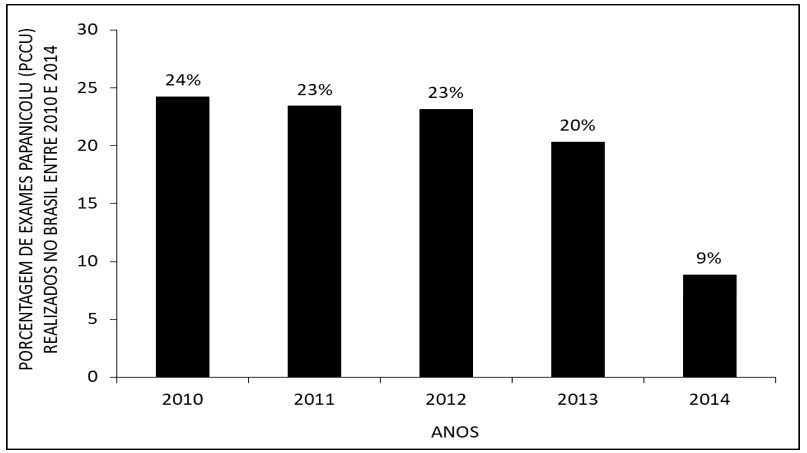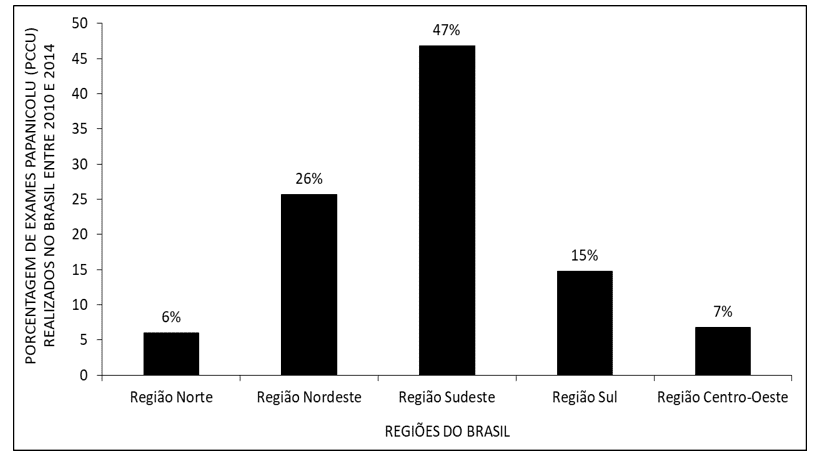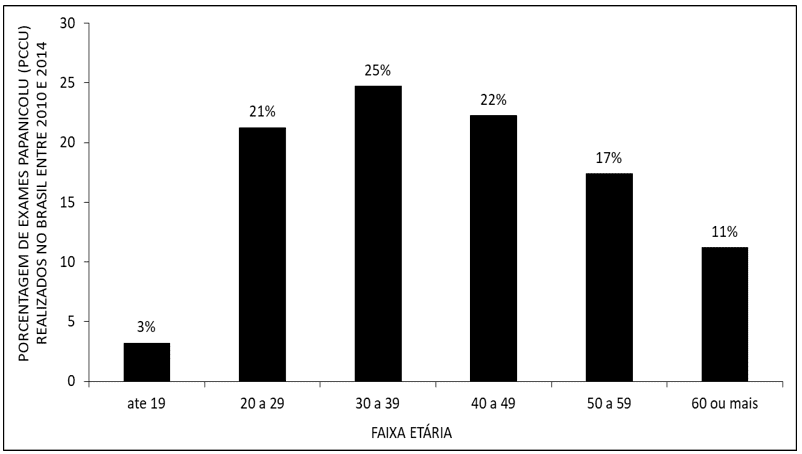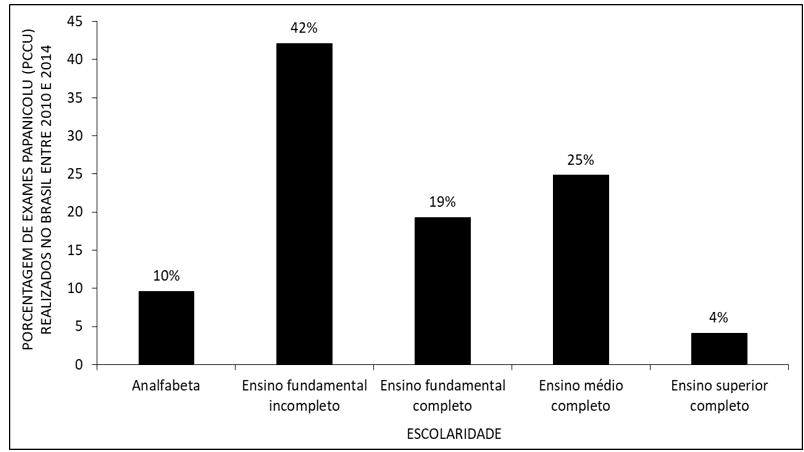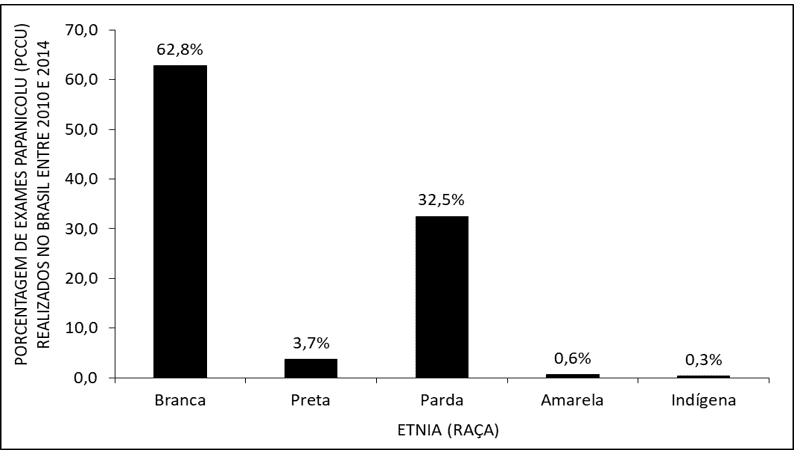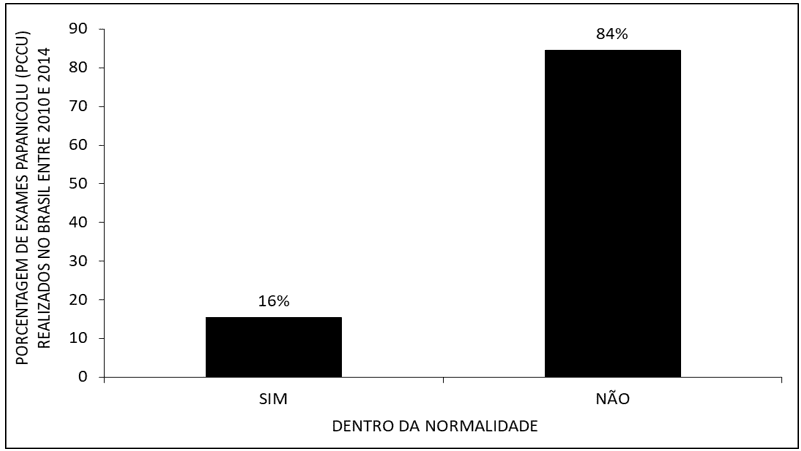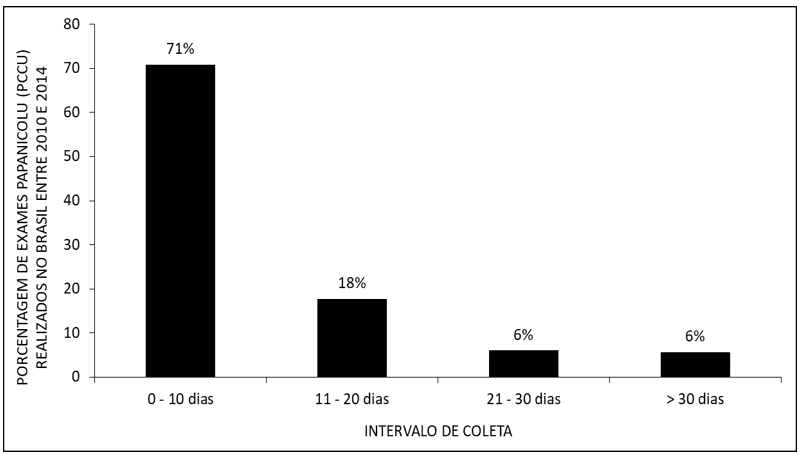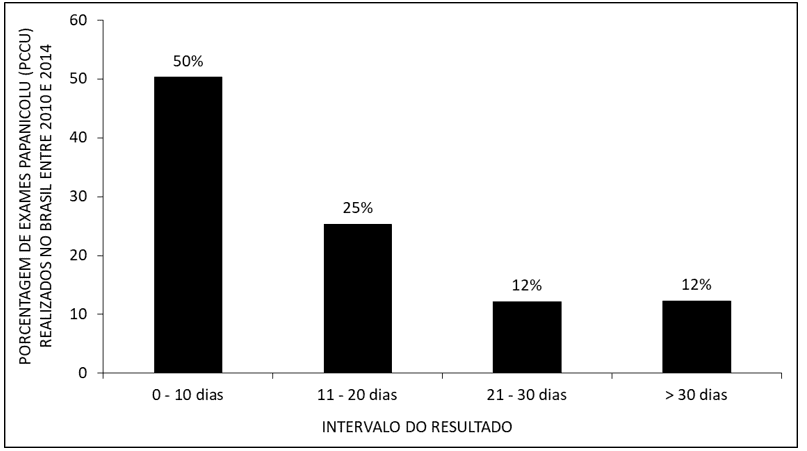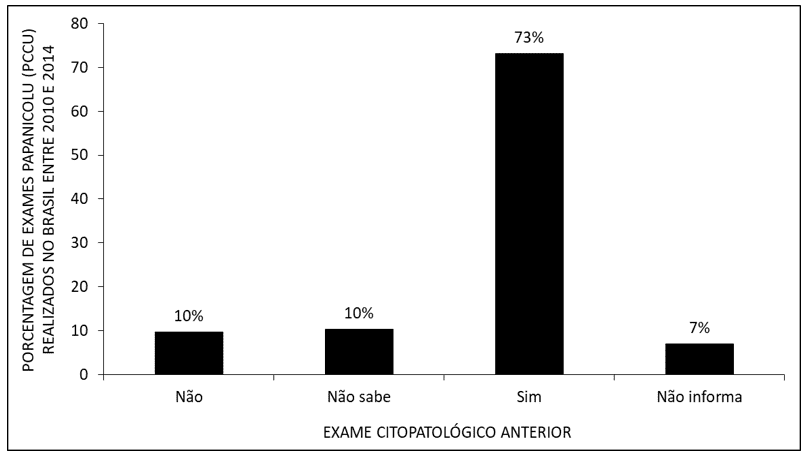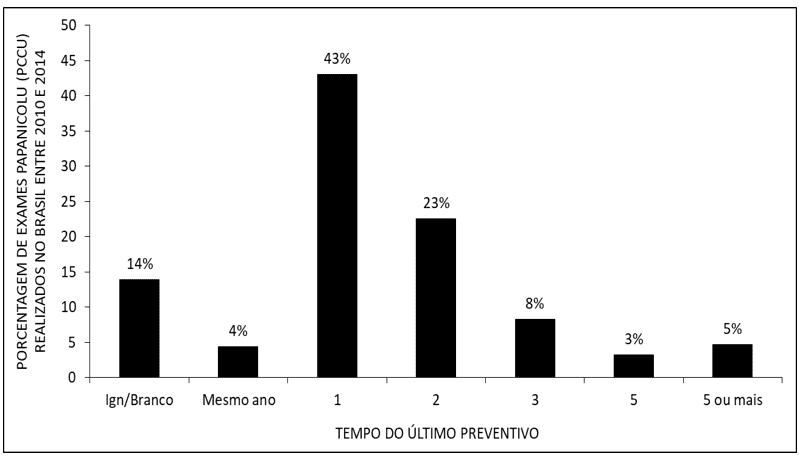ORIGINAL ARTICLE
FARIAS, Rafaela Santos [1], FACCO, Lucas [2], FECURY, Amanda Alves [3], ARAÚJO, Maria Helena Mendonça de [4], OLIVEIRA, Euzébio de [5], DENDASCK, Carla Viana [6], SOUZA, Keulle Oliveira da [7], DIAS, Claudio Alberto Gellis de Mattos [8]
FARIAS, Rafaela Santos. Et al. Confirmed cases of cervical cancer in Brazil between 2010 and 2014. Revista Científica Multidisciplinar Núcleo do Conhecimento. Year 05, Ed. 11, Vol. 25, pp. 93-104. November 2020. ISSN: 2448-0959, Access Link: https://www.nucleodoconhecimento.com.br/health/cervical-cancer, DOI: 10.32749/nucleodoconhecimento.com.br/health/cervical-cancer
SUMMARY
The Pap smear (PCCU) is a gynecological examination performed in women in order to detect damage to the cervix. Changes can be observed as a tissue disorder that makes up it. The objective of this work is to show confirmed cases of cervical cancer in Brazil between 2010 and 2014. The research was conducted with data taken from DATASUS (http://datasus.saude.gov.br). When there is good performance to prevent a disease considered serious, the result is satisfactory and effective. Through the results obtained by analyzing the data between the years 2010 and 2014, respectively, it is concluded that over the years the search for the test gradually increased, but some aspects persisted, such as the shame of performing the pcc test, fear, pain, among others. However, the results showed a high rate of tests in the southeast region and a lower rate in the north, with low dissemination and little awareness for women in the northern region. Therefore, the dissemination, awareness and performance of the cytopathological examination is very important for the prevention of cervical cancer, which today is the leading cause of mortality among Brazilian women
Keywords: Epidemiology, cervical cancer, PCCU, Cytopathology.
INTRODUCTION
Preventive tests are performed to identify possible diseases and treat them in their beginnings (BRASIL, 2013). The Pap smear (PCCU) is a gynecological examination performed in women in order to detect damage to the cervix, which can become harmful to health (TEIXEIRA et al., 2015). This test is used to discover early changes in the cervix. It assists in the early diagnosis of female cancer, and can be treated in its initial state, thus avoiding an increase in the mortality rate among women (ARAÚJO et al., 2016). This examination should be performed by women who have a sexually active life or who are over 18 years of age. It relies on collecting and analyzing cervical samples to identify cancer (BARBER et al., 2009).
Changes can be observed as a tissue disorder that makes up the cervix. This disorder can be subdivided into degrees. Grade 1 (I) occurs when a slight disordering of the cells occurs, compromising small parts of the tissue. When this cellular disordering reaches up to three quarters of the tissue, it is considered in Grade 2 (II). In Grade 3 (III) it is observed that the arrangement of cells is totally disordered, identifying the so-called cervical cancer (MENETRIER et al., 2016).
The number of PCCU exams performed in Brazil in 2010 were approximately 10 million exams per year. This amount of pap smear scans varied among Brazilian regions. In the northern region, 603,738 (six hundred and three thousand seven hundred and thirty-eight) examinations were performed. The northeast region performed 2,616,344 (Two million six hundred and sixteen thousand three hundred and forty-four) examinations. In the Midwest, 745,875 (Seven hundred and forty-five thousand eight hundred and seventy-five) examinations were performed. In the southeast, 4,703,400 (four million seven hundred and three thousand four hundred) people were examined. In the southern region, 1,606,119 (One million six hundred and six thousand hundred and nineteen) examinations (BORTOLON et al., 2012).
The number of PCCU exams performed in 2010 in the northern region of Brazil varies according to each state that composes it. In Amapá, 19,657 (Nineteen thousand six hundred and fifty) examinations were performed. In Acre, 53,754 (Fifty-three thousand seven hundred and fifty-four) examinations were performed. In amazonas 134.268 (One hundred and thirty-four thousand two hundred and sixty-eight) examinations performed. In the state of Pará, 191,298 (One hundred and ninety-one thousand two hundred and ninety-eight) examinations. In Rondônia 92,085 (Ninety-two thousand and eighty-two) examinations performed. In the state of Roraima, 28,614 (Twenty-eight thousand six hundred and fourteen) examinations were performed. In Tocantins, 84,062 (eighty-four thousand and sixty-two) tests were performed (BORTOLON et al., 2012).
Goal
Show confirmed cases of cervical cancer in Brazil between 2010 and 2014.
Method
The research was carried out with data taken from DATASUS (http://datasus.saude.gov.br) following the following steps: first, the “access to information” Tab was selected, followed by the option “health information (TABNET)” soon after the sub-option “Epidemiological and Morbidity” after accessing the option group “Cervical and breast cancer (SISCOLO/SISMAMA). Next, the icon “Cervical and breast cancer – since 2000” was selected. The “Siscolo 4.00 or higher” tab was opened and the option “Cervico-vaginal cytopathologic examination and microflora-procedure 12.011.01-0” was selected. Then clicked on “Brazil/regions”. For data collection, the “Year of competence” option was selected in the line field. In the content field, the “Number of Exams” option was selected. In the column field the options were “Not active”; “year of competence”; Year of competence”; “Reg.residência”; “Schooling”; “Color/Race”; “Within normal limits”; “Interv collects”; “Interv result”; “Cytopatol.Previous”; and “Últ Time.Prevent.” For all options, data were collected from 2010 to 2014. The “Month/Year of Competence” option was also selected in the column field in the column field, and in the content field the “Number of Exams” option for the same years. The data was compiled within the Excel application, a component of the Microsoft Corporation Office suite. The bibliographic research was carried out in scientific articles, using for the search computers of the computer laboratory of the Federal Institute of Education, Science and Technology of Amapá, Câmpus Macapá, located at: Rodovia BR 210 KM 3, s/n – Bairro Brasil Novo, CEP: 68.909-398, Macapá, Amapá, Brazil.
Results
Figure 1 shows the percentage of Pap smear scans (PCCU) performed in Brazil between 2010 and 2014. Between 2010 and 2013 the number of tests remained practically stable. In 2014, the data show that there was a sharp decrease in the performance of exams in the country.
Figure 1 Shows the percentage of Pap smear scans (PCCU) performed in Brazil between 2010 and 2014.
Figure 2 shows the percentage of Pap smear scans performed in Brazil between 2010 and 2014, by regions of the country. Showing a higher rate of tests performed in the southeast region and a lower number of tests in the northeast, south, midwest and north regions, respectively.
Figure 2 Shows the percentage of Pap smear scans (PCCU) performed in Brazil between 2010 and 2014, by regions of the country.
Figure 3 shows the percentage of Pap smear scans (PCCU) performed in Brazil between 2010 and 2014, according to age group. The data show that the largest number of tests is performed among women aged 30 to 39 years. The smallest is in the age group of women up to 19 years.
Figure 3 Shows the percentage of Pap smear scans (PCCU) performed in Brazil between 2010 and 2014. according to age group.
Figure 4 shows the percentage of Pap smear scans (PCCU) performed in Brazil between 2010 and 2014, by schooling. Showing that most women who take the exam have incomplete elementary school. While the smallest amount has completed higher education.
Figure 4 Shows the percentage of Pap smear tests (PCCU) performed in Brazil between 2010 and 2014, by schooling.
Figure 5 shows the percentage of Pap smear scans (PCCU) performed in Brazil between 2010 and 2014, by ethnicity. Women of white and brown ethnicity perform a large number of tests compared to black, yellow and indigenous women.
Figure 5 Shows the percentage of Pap smear scans (PCCU) performed in Brazil between 2010 and 2014, by ethnicity.
Figure 6 shows the percentage of Pap smear scans performed in Brazil, within the normal range, between 2010 and 2014. Among the tests performed, the data show that the majority is not within the normal range.
Figure 6 Shows the percentage of Pap smear tests performed in Brazil, within the normal range, between 2010 and 2014.
Figure 7 shows the percentage of Pap smear scans (PCCU) performed in Brazil between 2010 and 2014, per collection interval. The tests were mostly collected in the interval of up to 10 days, while the smallest amount has a collection interval greater than 30 days.
Figure 7 Shows the percentage of Pap smear tests (PCCU) performed in Brazil between 2010 and 2014, by collection interval.
Figure 8 shows the percentage of Pap smear scans (PCCU) performed in Brazil between 2010 and 2014, by result interval. Showing that most results were released within 10 days. While the smallest amount in more than 30 days.
Figure 8 Shows the percentage of Pap smear tests (PCCU) performed in Brazil between 2010 and 2014, by result interval.
Figure 9 shows the percentage of Pap smear scans (PCCU) performed in Brazil between 2010 and 2014, according to a previous cytological examination. Most of the women surveyed had previously undergone tests.
Figure 9 Shows the percentage of Pap smear scans (PCCU) performed in Brazil between 2010 and 2014, according to previous cytological examination.
Figure 10 shows the percentage of Pap smear scans (PCCU) performed in Brazil between 2010 and 2014, according to the time of the last preventive. The data show that most women take exams from year to year.
Figure 10 Shows the percentage of Pap smear tests (PCCU) performed in Brazil between 2010 and 2014, according to the time of the last preventive.
Discussion
The data show a marked decrease in the performance of the tests in the country (figure 1). Some factors seem to influence this decrease, such as lack of knowledge of the importance of the examination and fear of the examination; shame of exposure of the genitalorgans; difficulty in accessing UBSs; lack of preparation of professionals regarding the respect, guidance and information provided to patients about the examination (SANTOS and VARELA, 2015).
The data show a higher rate of examinations in the southeast region and a lower number of tests in the northeast, south, midwest and north regions, respectively (figure 2). This is based on the knowledge, information and awareness of women in the treatment of cervical cancer prevention. In the other regions, there was low positivity of tests. As a result, Amapá, which is located in the Northern Region, found less testing reaching a percentage lower than 1.0% positivity. As well as in the northeast, south and midwest regions. It was noticed that these regions did not have participation and awareness of women, because the low scientific knowledge about the performance of the exam is a factor that, in any case, may hinder the search for the pccu exam. Some reasons justify this fact, such as shame, feeling of fear, embarrassment during the examination, lack of time, lack of interest and lack of information about the cytopathological examination (BORTOLON et al., 2012).
The data show that the highest number of tests is performed among women aged 30 to 39 years and the lowest number among women up to 19 years (figure 3). The beginning of the collection of exams should be at 25 years of age regardless of whether the patient has an active sexual life or not. A large amount of the pap smear is performed in the age groups of 30 to 39 years, according to the table. The examination should follow until the age of 64 years and should be interrupted after performing two tests whose results are negative, two tests should be performed with interval times of one to three years. All women who have an active sexual life or older than 18 years is able to perform the preventive examination pccu, but this test is not yet fully acquired by the Brazilian women, it is known that Brazil has a high mortality rate from cervical cancer. This is because most women seek treatment to a more advanced degree, which is most often found in women aged 30 to 39 years. According to table 3, it was analyzed that the lowest number of tests performed is among women aged 19 years, precisely due to the lack of information about the pccu exam and the fear of performing it (BRASIL, 2014).
The majority of women taking the exam have incomplete elementary school and minority higher education (figure 4). In this table it was noted that the more studies and school education women have, the less they are interested in performing the preventive examination pccu. The reason for this result is related to beliefs and attitudes in health. 29.6% reported that they did not remember why they did not attend the test. Some reasons are due to fear, shame, discomfort and pain. We obtained unexpected results in Table 4, because we noticed a high rate of number of pccu exams performed by women who have incomplete elementary school because generally, women who do not have incomplete schooling tend to build families earlier, and as a result, they have more children than women who have a higher level of education. Consequently, these women go to the doctor more frequently, obtaining a high rate of pap smear (SILVA et al.,2015).
Women of white and brown ethnicity perform a large number of tests compared to black, yellow and indigenous women (figure 5). It was noticed that much of the non-pap smear is associated with ethnicity, and much of this resistance is related to factors such as inequalities of race/ethnicity, as well as in relation to the restricted access that a given race has. As shown in table (5). However, the low coverage and lack of accessibility among the other groups is explained by the access and differentiated treatment they have when they arrive at the place of the exam (PINHO E JUNIOR, 2003).
The data show that most of the tests performed are not within the normal range (Figure 6). A large part of the female population is out of the ordinary when performing the pap smear. This is because women seek to take the exam in a slightly more advanced state. This is also explained by the fact that most women have more than one sexual partner, with tendencies to contract HPV (human papillomavirus), a sexually transmitted disease. Where there may be cellular disorganization in the tissue that makes up the cervix (NORONHA et al., 2005; OLIVEIRA et al., 2016)).
The tests were mostly collected in the interval of up to 10 days and the smallest amount had a collection interval greater than 30 days (figure 7). The collection interval is most often shorter and has an interval duration of 10 working days. The professional reads the blade and impressions the result during this period, the pccu examination is collected during a gynecological consultation, and during the consultation a vaginal speculum is inserted without any lubricant action, which may cause a small discomfort. Before collecting the patient should not have sex the day before. It should be performed outside the menstrual period to obtain a more effective result (BRITO and NERY, 2007).
Most of the results were released within 10 days and the lowest amount in more than 30 days (figure 8). In relation to the pap smear, 46.55% of the women underwent the test. However, 57.8% perform in private networks, and the results of the examination are much faster, as the results of women who perform the pccu exam by the SUS network that has a longer delivery time than expected (MURATA et al., 2012).
Most of the women surveyed had previously undergone tests (Figure 9). Among the women who are aware of the PCCU exam, most of them perform the exam frequently, or have performed before. Believing that with the performance of the pccu examination in certain periods will avoid, thus, future diseases, such as cervical cancer. Because it is an effective test that if diagnosed at the beginning, it may have a 100% chance of cure (BARBEIRO et al., 2009).
The data show that most women take exams from year to year (figure 10). Most women go to the doctor to perform cervical cancer examination with the intention of preventing diseases, and treat them at first, to avoid problems in the future. It is recommended to perform the pccu exam annually, from year to year, to analyze and evaluate if there was or occurred any alteration as was the result of the previous examination. Women who care about their health take the exam with periods of time in 1 to two years, as shown in figure (10) (PINHO and JUNIOR, 2003; MELO et al., 2019).
CONCLUSION
This study showed that when there is a good performance to prevent a disease considered severe, the result is satisfactory and effective. It is important that they have disclosures and information about the preventive examination, but it is known that the prevention itself is done only with the performance of the pap smear to detect early the level of the degree that the cancer is. That when treated at first has a high chance of cure.
Through the results obtained by analyzing the data between the years 2010 and 2014, respectively, it is concluded that over the years the search for the test gradually increased, but some aspects persisted, such as the shame of performing the pcc test, fear, pain, among others. However, the results showed a high rate of examinations in the southeast region and a lower index in the north region. The data show low disclosure and low awareness for women in the northern region. Therefore, the dissemination, awareness and performance of the cytopathological examination is very important for the prevention of cervical cancer, which today is the leading cause of mortality among Brazilian women
REFERENCES
ARAÚJO, R.M.; CUNHA, H.C.O.; FERREIRA, V.G.C.; TRINDADE, M.P.; SOUZA, H.S.L. a importância da realização do exame papanicolau como instrumento de prevenção do câncer de colo do útero: uma revisão integrativa de literatura, Anais do V Congresso de Educação em Saúde da Amazônia. COESA. Universidade Federal do Pará. 2359-084. 2016.
BARBEIRO, F.M.S.; CORTEZ, E.A.; OLIVEIRA, P.A.M.C.; SILVA, A.L.O.; conhecimentos e práticas das mulheres acerca do exame papanicolau e prevenção do câncer cérvico-uterino. Cuidado é fundamental. 1(2):414-422. 2009.
BORTOLON, P.C.; SILVA, M.A.F.; CORRÊA, F.M.; DIAS, M.B.K.; KNUPP, V.M.A.; ASSIS, A.; CLARO, I.B. Avaliação da Qualidade dos Laboratórios de Citopatologia do Colo do Útero no Brasil. Revista Brasileira de Cancerologia. 58(3),435-444,2012.
BRASIL. Ministério da Saúde. Secretaria de Atenção à Saúde. Departamento de Atenção Básica. Controle dos cânceres do colo do útero e da mama / Ministério da Saúde, Secretaria de Atenção à Saúde, Departamento de Atenção Básica. – 2. ed. – Brasília: Editora do Ministério da Saúde, 2014. 124 p.
BRASIL. Ministério da Saúde. Secretaria de Atenção à Saúde. Departamento de Atenção Básica. Controle dos cânceres do colo do útero e da mama. Ministério da Saúde. 2. ed. – Brasília: Editora do Ministério da Saúde. 124 p. 2013.
MELO, Carolina Simas. Et al. Caracterização epidemiológica dos óbitos no Brasil por macrorregião de 2016 a 2018. Revista Científica Multidisciplinar Núcleo do Conhecimento. Ano 04, Ed. 12, Vol. 01, pp. 05-17, 2019. Link de acesso: https://www.nucleodoconhecimento.com.br/saude/obitos-no-brasil
MENETRIER, J.V.; BOING, A.; MEDEIROS, K.A. Alterações citopatológicas do colo uterino em mulheres atendidas na 8a Regional de Saúde do Paraná no ano de 2014. Espaço para a Saúde – Revista de Saúde Pública do Paraná. V. 17, n. 2, p. 169-177, 2016.
MURATA, I.M.H.; GRABRIELLONI, M.C.; SCHIRMER J. Cobertura do Papanicolau em mulheres de 25 a 59 anos de Maringá – PR, Brasil. Rev Bras Cancerol.58(3):409-15, 2012.
NORONHA, V.L.; NORONHA, R.; CARMONA, B.; MACEDO, L.A.; CRUZ, E.M.; NAUM, C.; MELLO, W.; VILLA, L. Papilomavírus humano (hpv) em mulheres com citologia oncótica dentro dos limites da normalidade. ARTICLE. 17(1): 49-55, 2005.
OLIVEIRA, R.C.E.. et. al. Perfil epidemiológico do HPV da população feminina sexualmente ativa, na faixa etária de 10 a 80 anos. Revista Científica Multidisciplinar Núcleo do Conhecimento. Ano 01, Ed. 07, Vol. 04, pp. 21-34, 2016. Link de acesso: https://www.nucleodoconhecimento.com.br/saude/hpv
PINHO, A.A; JUNIOR, I.F. Prevenção do câncer de colo do útero: um modelo teórico para analisar o acesso e a utilização do teste de Papanicolaou. Rev. Bras. Saude Mater. Infant. n.1 Recife jan./mar. 2003.
RICO, A.M.; SILVA, G.A.; LOWY, I.; TEIXEIRA, L. (Org.) et al. Câncer de mama, câncer de colo de útero: conhecimentos, políticas e práticas. Outras Letras. 256 p. 2015.
SANTOS, A.C.S.; VARELA, C.D.S. Prevenção do câncer de colo uterino: motivos que influenciam a não realização do exame de papanicolaou. Revista Enfermagem Contemporânea. 4(2):179-188, 2015.
SILVA, M.A; TEIXEIRA, E.M.B; FERRARI, R.A.P; CESTARI, M.E.W; CARDELLI, A.M. Fatores relacionados a não adesão à realização do exame de Papanicolau. Rev Rene. 16(4).532-9. 2015.
[1] Mining Technique, as a result of the Federal Institute of Amapá (IFAP).
[2] Student of the Medical Course of the Federal University of Amapá (UNIFAP).
[3] Biomedical, PhD in Tropical Diseases, Professor and researcher of the Medical Course of the Federal University of Amapá (UNIFAP).
[4] Physician, Professor and researcher of the Medical Course of the Federal University of Amapá (UNIFAP).
[5] Biologist, PhD in Topical Diseases, Professor and researcher of the Physical Education Course of the Federal University of Pará (UFPA).
[6] Theologian, PhD in Psychoanalysis, researcher at the Center for Research and Advanced Studies – CEPA.
[7] Sociologist, Master’s student in Anthropic Studies in the Amazon, Member of the Research Group “Laboratory of Education, Environment and Health” (LEMAS/UFPA).
[8] Biologist, PhD in Theory and Behavior Research, Professor and researcher of the Graduate Program in Professional and Technological Education (PROFEPT), Federal Institute of Amapá (IFAP).
Submitted: November, 2020.
Approved: November, 2020.
